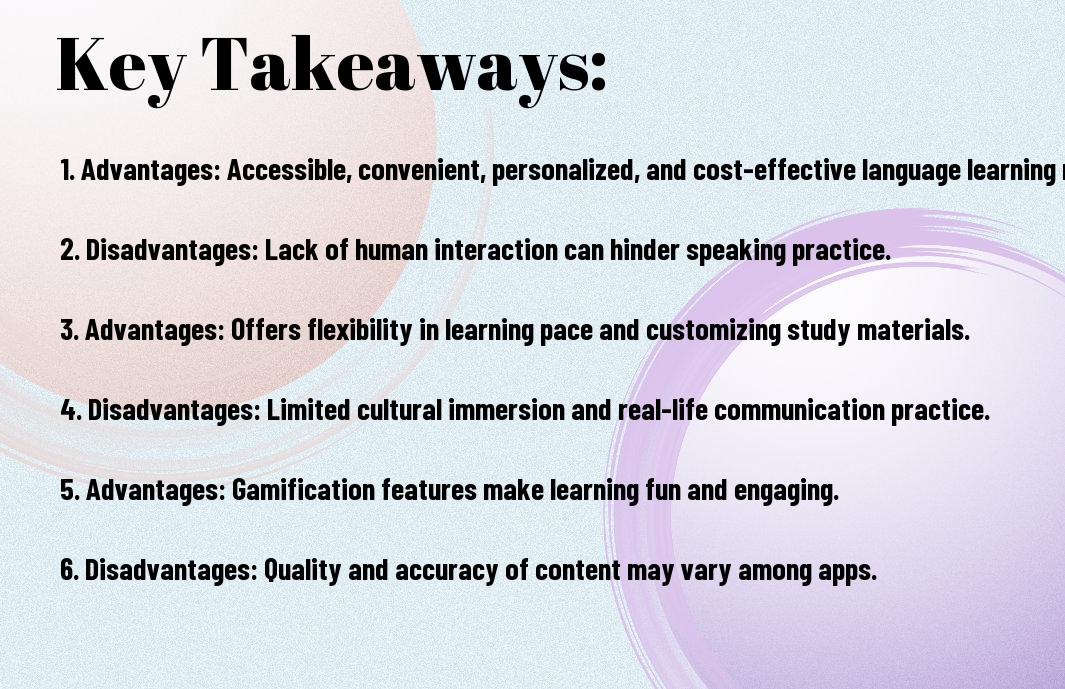If you’re considering using language apps to improve your language skills, it’s important to weigh the advantages and disadvantages they offer. Language apps can provide convenient and flexible learning opportunities, allowing you to practice anytime, anywhere. On the downside, they may lack the interactive and immersive experience of traditional classes, leading to limited speaking and listening practice. Understanding the pros and cons of language apps can help you make an informed decision on how to best achieve your language learning goals.
Key Takeaways:
- Advantages:
- Convenience: Language learning apps provide flexibility for users to study at their own pace and time.
- Interactive Learning: Apps often use gamification and interactive features to make learning engaging and fun.
- Cost-effective: Many language learning apps offer free or affordable options compared to traditional language courses.
- Disadvantages:
- Lack of Personalized Support: Apps may not provide personalized feedback or guidance from instructors.
- Over-reliance on Technology: Using apps exclusively may limit real-world practice and interaction with native speakers.
- Limited Content: Some apps may have a restricted range of vocabulary and topics compared to comprehensive language courses.


Advantages of Language Learning Apps
Convenience and Accessibility
One of the biggest advantages of language learning apps is the convenience and accessibility they offer. You can access these apps anytime, anywhere, making it easy to fit language learning into your busy schedule. Whether you’re on a bus, waiting in line, or relaxing at home, you can pull out your phone and start learning a new language with just a few taps.
Personalization and Flexibility
Accessibility is key when it comes to language learning apps. These apps allow you to personalize your learning journey based on your proficiency level, interests, and goals. You can choose what, how, and when you want to learn, providing a flexible learning experience that caters to your individual needs.
Convenience is further enhanced by the ability to practice at your own pace. Whether you want to spend 5 minutes or an hour learning each day, language learning apps adapt to your schedule, ensuring that you make progress at a pace that works best for you.
Cost-Effective
The cost-effectiveness of language learning apps is another significant advantage. Many of these apps offer free versions with basic features, making language learning accessible to everyone. Even premium versions of these apps are often more affordable than traditional language courses, providing great value for the resources and tools they offer.
Apps typically offer a variety of subscription options, allowing you to choose the one that fits your budget and learning needs. With the ability to access quality language education at a fraction of the price of traditional methods, language learning apps are a cost-effective solution for those looking to learn a new language.
Interactive and Engaging
Language learning apps are designed to be interactive and engaging, keeping you motivated and excited to learn. Interactive exercises, games, quizzes, and challenges make the learning process fun and enjoyable, turning language learning from a chore into an engaging activity that you look forward to.
Engaging features such as voice recognition, pronunciation practice, and real-time feedback help you stay engaged and improve your language skills effectively. By making learning enjoyable and interactive, language learning apps increase your chances of sticking with your language learning journey and achieving long-term success.
Improved Learning Outcomes
Enhanced Vocabulary
The use of language learning apps can significantly improve your vocabulary. These apps offer a wide range of words and phrases for you to learn, often with interactive exercises that help reinforce your memory. By consistently practicing with these apps, you can quickly expand your vocabulary and retain new words more effectively.
Better Grammar and Syntax
One of the advantages of language learning apps is the focus on grammar and syntax. These apps provide explanations on grammar rules and sentence structures in a clear and concise manner. By completing grammar exercises and practicing sentence formation, you can enhance your understanding of the language’s rules and improve your overall proficiency.
Moreover, many language learning apps offer instant feedback on your grammar exercises, pointing out errors and providing explanations. This immediate feedback can help you correct your mistakes and learn from them, leading to a better grasp of grammar and syntax.
Pronunciation Improvement
Enhanced pronunciation is a significant benefit of using language learning apps. These apps often include audio features that allow you to listen to native speakers pronouncing words and phrases. By imitating these pronunciations and practicing aloud, you can refine your own pronunciation skills and sound more like a native speaker.
On top of that, some apps use voice recognition technology to analyze and provide feedback on your pronunciation. This real-time feedback can help you make adjustments to your pronunciation, leading to more accurate and fluent speech.
Increased Confidence
Confidence in speaking a new language is crucial, and language learning apps can help boost your confidence levels. By providing a supportive and non-judgmental environment for you to practice speaking, these apps can help you gain the confidence to communicate effectively in real-life situations. The more you practice and improve your skills with the app, the more confident you’ll feel when using the language in the real world.
Grammar and vocabulary exercises in these apps also contribute to your overall confidence by solidifying your understanding of the language. As you see yourself making progress and becoming more proficient, your confidence in your language abilities will naturally increase.

Disadvantages of Language Learning Apps
Once again, while language learning apps offer convenience and flexibility, there are downsides to consider. Let’s explore some of the disadvantages you may encounter when using these apps.
Limited Human Interaction
Language learning apps often lack the personal touch that comes from interacting with a real person. While these apps can provide automated feedback and corrections, they cannot replace the value of a conversation with a native speaker. Human interaction is crucial for practicing pronunciation, understanding cultural nuances, and building confidence in a new language.
Lack of Immersion
The immersive experience of being surrounded by a language is missing when using language learning apps. Immersion helps you think and understand in the target language without translating back to your native language. In real-life immersion, you are forced to communicate in the target language, accelerating your learning process. Apps may not fully replicate this experience, potentially slowing down your progress.
Understanding the context in which language is used is vital for grasping its nuances and cultural significance. Apps may not always provide this context, leading to a shallow understanding of the language you are trying to learn.
Overreliance on Technology
Apps can make language learning seem like a solitary activity, leading to overreliance on technology. While apps can be a valuable tool, they should not be your only resource. It’s imperative to complement app-based learning with real-life practice, such as conversations with native speakers or immersion experiences. Relying solely on technology may limit your ability to communicate effectively in real-world situations.
Quality Control Issues
Anybody can create a language learning app, leading to variations in quality and effectiveness. Some apps may contain errors in grammar, pronunciation, or vocabulary, which can hinder your learning progress. It’s imperative to research and choose reputable apps with good reviews and proven success rates to ensure you are receiving accurate and reliable language instruction.
A diverse range of language learning apps are available, each with its strengths and weaknesses. It’s crucial to understand the potential drawbacks of these apps to make informed decisions about incorporating them into your language learning journey.
Technical Limitations
Internet Connectivity Requirements
The use of language learning apps often requires a stable internet connection. The apps rely on being able to connect to their servers to access lessons, exercises, and other content. If your internet connection is spotty or slow, it can lead to frustrating delays or interruptions in your learning process. Additionally, if you are in an area with limited access to the internet, you may find it challenging to use the app effectively.
Compatibility Issues
Connectivity issues can also arise from compatibility problems between the language learning app and your device. Some apps may not be optimized for certain operating systems or versions, leading to glitches, crashes, or other technical difficulties. It is necessary to ensure that the app you choose is compatible with your device to avoid any interruptions in your learning experience.
It is recommended to regularly check for updates and ensure that your device meets the requirements for running the app smoothly. This can help minimize compatibility issues and ensure a more seamless language learning experience.
Limited Offline Access
Some language learning apps offer limited offline access to their content. This means that you may not be able to access lessons or practice exercises without an internet connection. If you are in a location with poor connectivity or traveling without access to Wi-Fi, this limitation can hinder your ability to consistently engage with the app.
Requirements for offline access vary depending on the app, so it is necessary to review the app’s specifications and plan accordingly. Pre-downloading lessons or content when you have a stable internet connection can help mitigate the impact of limited offline access.
Updates and Maintenance
On occasion, language learning apps require updates to fix bugs, improve performance, or add new features. It is crucial to stay on top of these updates to ensure that you are getting the best possible experience with the app. Failure to update the app regularly may result in glitches, security vulnerabilities, or compatibility issues.
With regular maintenance and updates, you can take advantage of the latest advancements in language learning technology and enjoy a smoother, more efficient learning experience. Make sure to enable automatic updates on your device or check for updates manually to keep your language learning app running smoothly.
Pedagogical Concerns
After reading Language Acquisition via Language Learning Apps, you may consider various pedagogical concerns when using language learning apps.
Teaching Methods and Approaches
For teaching methods and approaches, language learning apps often incorporate a mix of techniques such as flashcards, gamification, and interactive exercises to engage users. While this can make learning more enjoyable and dynamic, some apps may lack depth in terms of explaining grammatical rules or cultural contexts. It’s necessary to supplement app-based learning with additional resources to ensure a comprehensive understanding of the language.
Assessment and Evaluation
The assessment and evaluation aspect of language learning apps varies widely. Some apps offer quizzes and tests to gauge your progress, while others may provide limited feedback on your performance. It’s crucial to choose apps that provide detailed feedback and track your advancements accurately. Additionally, the lack of human interaction in app-based learning can sometimes hinder the effectiveness of assessment as real-time feedback from a teacher is invaluable.
Another important aspect to consider regarding assessment and evaluation is the adaptability of language learning apps to your individual progress. Some apps may not adjust their difficulty level according to your skills, leading to either boredom from repetitive content or frustration from overly challenging tasks. Look for apps that personalize learning based on your strengths and weaknesses to optimize your language acquisition journey.
Teacher-Student Interaction
Interaction with a teacher or language instructor is commonly absent in language learning apps, which can be a drawback for those who benefit from personalized guidance and feedback. While apps offer convenience and flexibility, they may lack the human touch necessary for addressing specific questions or providing encouragement. Supplementing app learning with occasional sessions with a language tutor can help bridge this gap and enhance your overall learning experience.
Assessment plays a crucial role in gauging your progress and identifying areas for improvement in language learning apps. While some apps provide self-assessment tools, external evaluation from a qualified language instructor can offer valuable insights into your language skills and help tailor your learning path accordingly.
Learning Style Accommodations
Interaction with language learning apps can accommodate various learning styles, whether you are a visual, auditory, or kinesthetic learner. Apps often include multimedia elements like videos, audio clips, and interactive games to cater to different preferences. However, it’s necessary to recognize your preferred learning style and choose apps that align with your strengths to make the most of your language learning experience.
Accommodations for different learning styles can significantly impact your language acquisition journey. By selecting apps that resonate with your preferred learning style, you can enhance engagement, retention, and overall enjoyment of the learning process. Consider exploring different apps to find the best fit for your individual learning preferences.
User Experience
User Interface and Design
One of the key factors in the user experience of language learning apps is the user interface and design. The way an app looks and functions can greatly impact how enjoyable and effective it is to use. Apps with clean, intuitive interfaces and visually appealing designs are more likely to keep you engaged and motivated to continue your language learning journey.
Navigation and Usability
The ease of navigation and usability of a language learning app is crucial for a smooth user experience. The app should be easy to navigate, with clear instructions on how to access different features and lessons. Intuitive design plays a significant role in how well you can use the app, making it easier for you to focus on learning rather than figuring out how to use the platform.
The navigation menus should be logically organized, allowing you to move between lessons, practice exercises, and progress tracking effortlessly. A user-friendly interface that promotes seamless navigation can enhance your overall learning experience.
Feedback and Support
With language learning apps, receiving feedback and support is necessary for your progress. Look for apps that provide immediate feedback on your exercises and pronunciation. This helps you correct mistakes promptly and improve your language skills more effectively. Additionally, access to support, whether through FAQs, customer service, or online communities, can be beneficial when you have questions or need assistance.
Support can come in various forms, such as live chat for immediate help, email support for more complex inquiries, or a robust FAQ section to address common issues. Having adequate feedback and support channels can make your language learning experience more efficient and rewarding.
Community Building
Community building features in language learning apps can enhance your overall experience by connecting you with other learners. Joining a community within the app allows you to practice language skills with peers, seek advice, and share your progress. It creates a sense of accountability and camaraderie that can motivate you to stay consistent in your learning journey.
Navigation through the community features should be straightforward, enabling you to participate in discussions, language exchange programs, or group activities effortlessly. Engaging with a community of like-minded individuals can make your language learning process more engaging and enjoyable.
Summing up
With this in mind, language learning apps offer several advantages such as convenience, cost-effectiveness, and the ability to learn at your own pace. They provide a flexible learning environment that caters to different learning styles and schedules. Moreover, they offer interactive and engaging exercises that make the learning process more enjoyable and effective. However, language learning apps also come with their disadvantages, including the lack of personalized feedback and the potential for distractions that may hinder your progress. It’s important to weigh these pros and cons carefully before choosing to solely rely on language learning apps for your language learning journey.
FAQ
Q: What are the advantages of language learning apps?
A: Language learning apps offer convenience and flexibility, allowing users to learn at their own pace and schedule. They provide a wide range of interactive features such as quizzes, games, and flashcards to make learning engaging and fun. Additionally, many language learning apps offer personalized learning paths tailored to the user’s level and goals.
Q: What are the disadvantages of language learning apps?
A: While language learning apps can be effective in improving vocabulary and grammar skills, they may not provide enough practice in real-life communication or listening comprehension. Some apps rely heavily on repetition and memorization, which may not suit all learning styles. Additionally, users may not receive immediate feedback or guidance from a teacher when using language learning apps.
Q: How can users maximize the benefits of language learning apps?
A: To make the most of language learning apps, users should supplement their learning with additional resources such as language exchange partners, online tutorials, or language classes. It’s important to set specific learning goals and dedicate regular time to practice using the app. Users can also track their progress, review past lessons, and seek feedback from native speakers to enhance their language skills.
